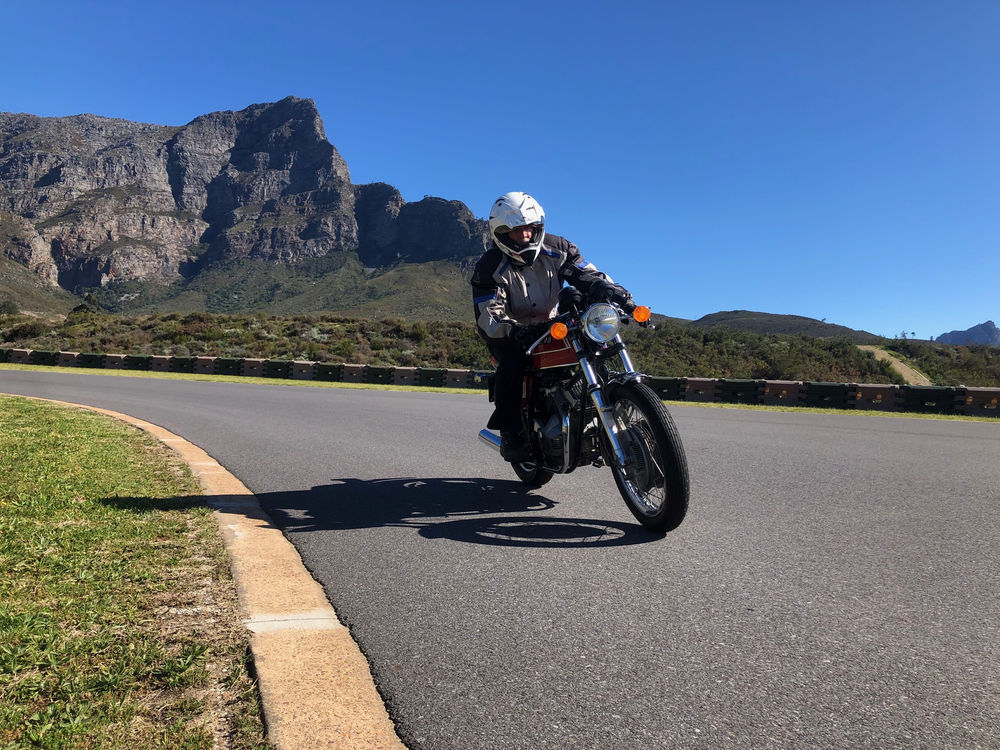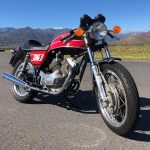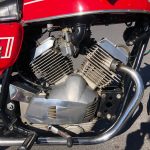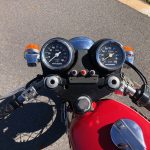
02 Sep On yer bike: 1973 Moto Morini
There is a smile on FMM Curator Wayne Harley’s face as he describes putting a long-ignored Italian machine back into action…
Ask the common man to name an Italian motorcycle and I’m sure the likes of Ducati, Moto-Guzzi, Aprilia and even Vespa would spring to mind. More knowledgeable individuals might also remember Gilera and MV Agusta, but Motor Morini is hardly ever mentioned, which is hard to fathom if one considers that it was around at the same time. When I started the sympathetic restoration of FMM’s 1973 Moto Morini 3½, I was amazed to see just how well made this bike is, making as much – and in some cases, more – power than its Italian cousins, with good looks and handling to match. So I decided to see if I could find out why Moto Morini and this great little 350 got so easily overlooked.
Motor Morini was founded by Alfonso Morini in 1937 in the city of Bologna. Alfonso was initially employed by Mario Mazzetti in 1925 to design and build motorcycles, but this arrangement did not last long and the two very soon parted ways. Morini switched to building 350 and 500cc motor-tricycles, but the onset of WW2 and his factory subsequently being bombed saw Morini having to close shop. After the war, Morini was able to reopen his factory rather quickly, and was back in production by late-1946. He also had to switch back to two-wheelers and found success with a motorcycle known as the T125, originally a two-stroke based on the DKW machine.
However, it didn’t take Morini long to move back to his favoured four-stroke engines, and in 1948 he introduced the 125 Competizione. The engine could spin to 10 000 r/min and this led to Morini’s first 125 GP wins in Italy and Spain. The 125 was quickly followed by the 175cc Settebello, which was the yardstick for many years in the Italian Junior Championship. The great Giacomo Agostini cut his teeth on one of Morini’s 175s. However it was the Bialbero twin-cam 250cc that was the pinnacle of 250 GP bikes, and for many years was seen as the fastest single cylinder 250 motorcycle in the world. Conceived by Morini, Dante Lambertini and Nerio Biavati, this team would mate a remarkable engine to a excellent chassis that in the hands of Tarquinio Provini almost won the 1963 250cc World Championship, if it wasn’t for the Honda 250-4 and Jim Redman.
But racing had become too expensive for Moto Morini, and the company set about building and selling small-capacity single cylinder motorcycles, all with four-stroke engines but not just as commuters, they set their focus on performance and dynamic riding, introducing many young Italian riders to an exhilarating ride long before his or her 16th birthday. Strangely enough, this new approach would also bring yet another title to Morini, even though the company was no longer officially racing any more. The success came in the form of its 125cc Regolarita, a kind of scrambler/enduro bike that won its class in the 1966 ISDT in Sweden. Along with the 100 and 150cc machines, these 125s could be found on the starting grids of many European enduro events up to 1970.
Sadly, in 1969 Alfonso Morini passed away, leaving his daughter Gabriella to take over control of the Moto Morini empire. Gabriella wisely employed Franco Lambertini (previously with Ferrari) who, incidentally, was no relation to Dante Lambertini mentioned earlier. Franco would be instrumental in the development and introduction of the new 72-degree V-twin engine that would power Motor Morinis into the 1980s. He used a Heron flat-head design and a toothed cam belt, thought to be the first time this set-up had been used for a motorcycle. These applications gave the new Morini engine a relatively strong performance and good reliability. Morini produced engines in 200, 350 and 500cc capacities. Lambertini even attempted a prototype 500cc turbocharged example that, sadly, was never put into production.
In 1986 Gabriella was forced to sell Moto Morini because of her failing health. The Castiglioni family bought the company and it became part of the Cagiva group, and since then I feel it lost its individuality. But why does it not have as much recognition as other Italian motorcycles? I still can’t say, although it may be because of a lack of ongoing racing success, a small model range, and never any large-capacity bikes. On top of this, they were rather expensive, but the truth is they were reliable, easy to maintain, fairly quick and rather beautiful looking bikes that sound great. So, what is it like to ride the 3½?
As with the Ducati MHR 900 SS that we featured in On Yer Bike back in April 2018, the Italian flair and attention to sports handling is very noticeable in the 3½ from the minute you pull away. The bike is very light – it only weighs 160kg – and is also very predictable. It feels well balanced; the tubular steel frame and spoked Borrani aluminum wheels help let you feel confident and in control through the clip-on handlebars. The riding position is typical café racer, and the lines of the little 3½ just suit this riding configuration. In GT form with its upright riding position, I’m sure the bike would lose some of its appeal. Performance? Considering that this bike was running for the first time in about 21years, and being only 350cc, I didn’t want to twist its ear too much. Power is not abundant with just 26 kW at 8 600 r/min, a top speed of around 160 km/h is claimed but I didn’t attempt a top speed run. It’s no rocket ship, but is still buckets of fun.
Initially, the gearbox was not all that smooth but got better the more I rode: operating the gear lever with the right foot always takes some getting used to. Stopping was surprisingly good even with the drum brakes. Later models did get a steel disc front brake.
If there is a fault it is with the electrical system, which is still a little suspect even after spending a lot of time on it. And then a left-footed kick start – ‘FOR PEET’S SAKE’! After years and years of kick-starting a bike on the right-hand side of a bike, switching to a left-sided kick start is like trying to write with my left hand; you can do it, but what a mess!
I have to admit with great shame that I’ve looked at the Moto Morini in the museum collection for about 20 years and never attempted to re-commission it. Now that I have done so, I realise just what a pleasant bike it is to ride, another fine classic that has put a massive smile on my face.









